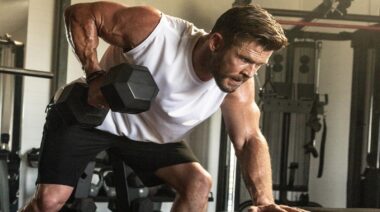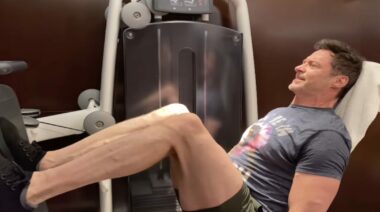The barbell shrug is a very misunderstood movement, a commonly passed-over exercise, and often an incorrectly executed one.
As a primitive or primal movement, the shrug is as commonplace as flexing your hand to coerce someone to hurry up. Second nature to us, this movement works some finer muscles of the back and the shoulder girdle. Specifically, the levator scapula, serratus anterior, rhomboids, and latissimus dorsi.
The Role of the Trapezius
This behemoth muscle stands at a height of vertebrae C1-T12 with a width of the acromion, clavicle, and spine of the scapula combined. Weighing in at approximately 2lbs to a 10lb maximum (on your average person), the trapezius is responsible for postural balance, specializing in elevating the pectoral girdle, retracting the scapula, depressing the shoulders, and rotating the scapula upwards while extending the neck.
The trapezius muscle, on a functional level, is a postural and active movement muscle used to tilt and turn the head and neck, shrug, stabilize the shoulders, and twist the arms. While it is commonly referred to as one muscle, the trapezius has three parts: the superior, middle, and inferior portions located on the dorsal or posterior side of the neck to the middle of the back.
Why Is Shrugging Important?
There are myriad of reasons shrugging is a basic movement but the most important aspects are:
- Shoulder girdle stability – Recovering from an injury to the shoulder and or brachial plexus, posture and physique/aesthetics such as in bodybuilding. Tom Hardy anyone?
- Ever try doing pulling, pressing movements, and/or Olympic lifts and get stuck right around the shoulder girdle area? You can blame yourself for not training your traps effectively.
- Shrugs present a way to overload a muscle group quite easily due to the upper traps yielding most from heavier loads.
In Dr. Parikh’s and Shah’s research, myofascial trigger points (MTrPs) common within the trapezius can be alleviated with proper exercise—in addition to dry needling in order to relieve pain and restore range of motion and function. These trigger points are usually caused by emotional stress, poor posture, smartphone use in excess, and heavy handbag carrying.
How to Train Your Traps
Shrugs should be done ideally in concert with shoulders training or on the tail end of a back workout. This is because when working the shoulders, it’s important to work external and internal rotation, anterior and posterior deltoids, as well as the supporting musculature of the rotator cuff. Due to working around the scapula, the trapezius will indirectly be stimulated.
The trapezius, especially the middle and lower traps, is severely underworked in general and thus shoulder work (i.e. military presses) suffer. By working them in concert versus individually, their importance as synergists is reinforced when active and antagonists when choosing to inhibit a range of motion (i.e. hyperextension of the neck during a heavy set of pressing).
On a pull day, movements such as deadlifting, rack pulls, pull-ups, and rowing require the trapezius to act both a stabilizer as well as an active mover depending on things such as angle and time under tension.
The upper traps should be trained with a greater time under tension according to the work of Hagg and Ojok. Ideally, stimulating the upper traps for three seconds on the loading phase and then holding for 3 seconds on the isometric phase prior to a 1 second descent or controlled relaxation phase.
The Barbell Shrug
When lifting maximal loads consider two approaches: deadlifting the weight or using a rack.
When using 50 to 60% maximal loads consider using a preloaded barbell and sitting with the weight behind your legs. For all intents and purposes, I’ll be demonstrating a maximal load barbell deadlift and you’ll see the engagement of primarily the upper part of the trapezius, the teres major, and teres minor, respectively.
- Begin by setting a weight on a generic barbell for your intermediate lifter.
- Deadlift the weight or squat down to pick up the weight using an overhand grip.
- Stop at the top with an erect spine while looking straight ahead with a slight bend in the knee.
- Jut the head slightly forward or lead with the chin.
- Allow the weight to ride the thigh (quadriceps) as you raise the shoulders and rotate them forward simultaneously for 3 seconds.
- Hold the weight at the top for 3 seconds.
- Return to the original starting location (whether this is the floor in a deadlift or standing from a rack).
Make Shrugging a Regular Part of Your Training
Shrugging needn’t be a fight with your trapezius muscles and your rotator cuff. It shouldn’t be a chore during your training, but through training, we can re-educate this massive muscle to be the most effective and efficient it can be.






